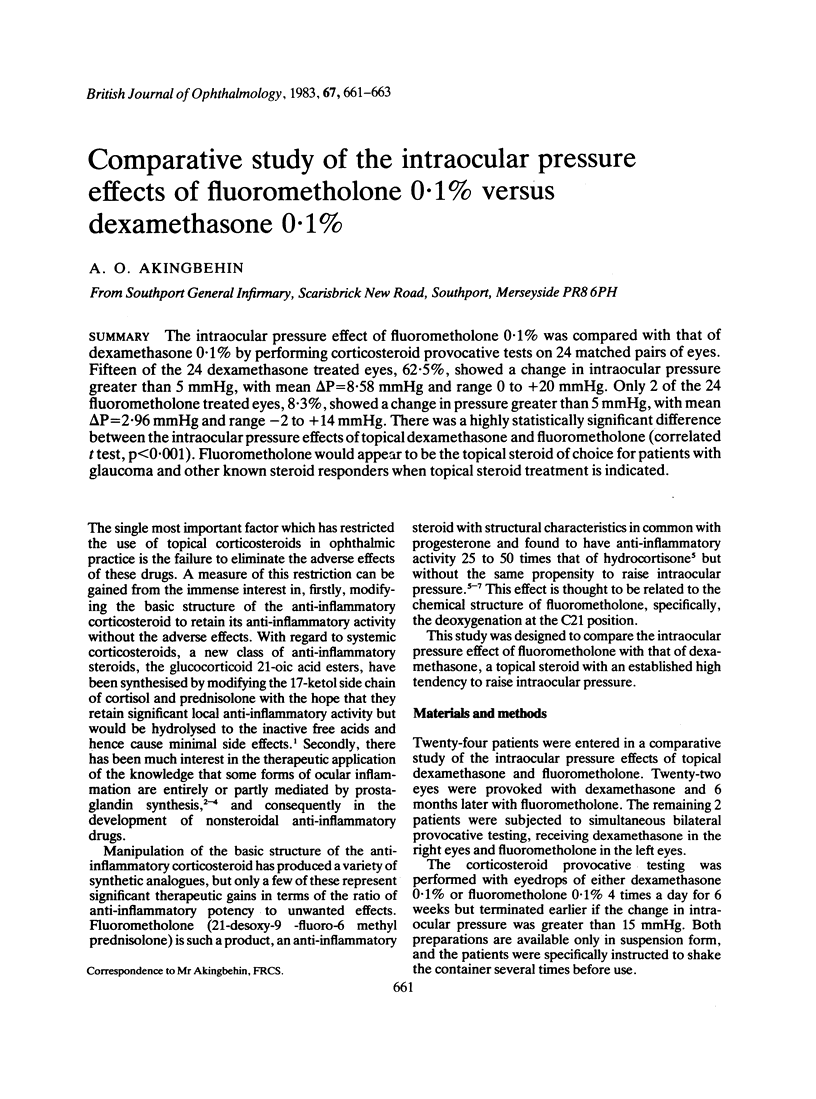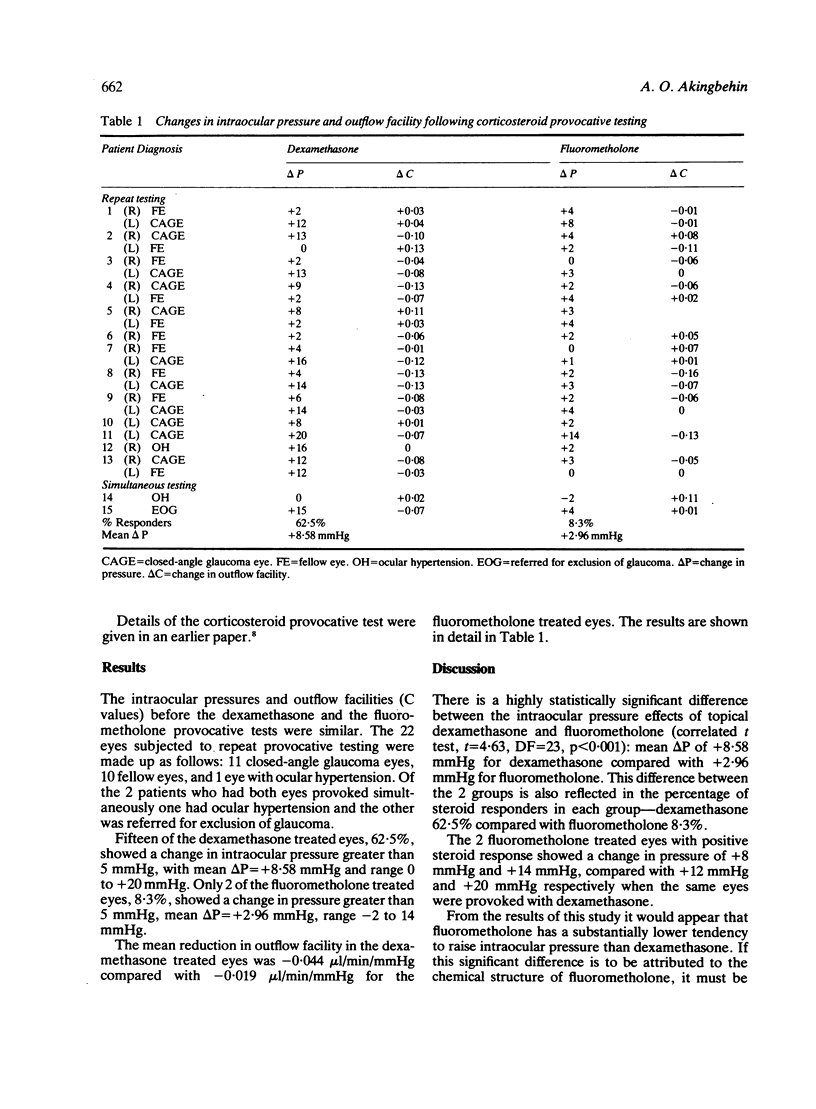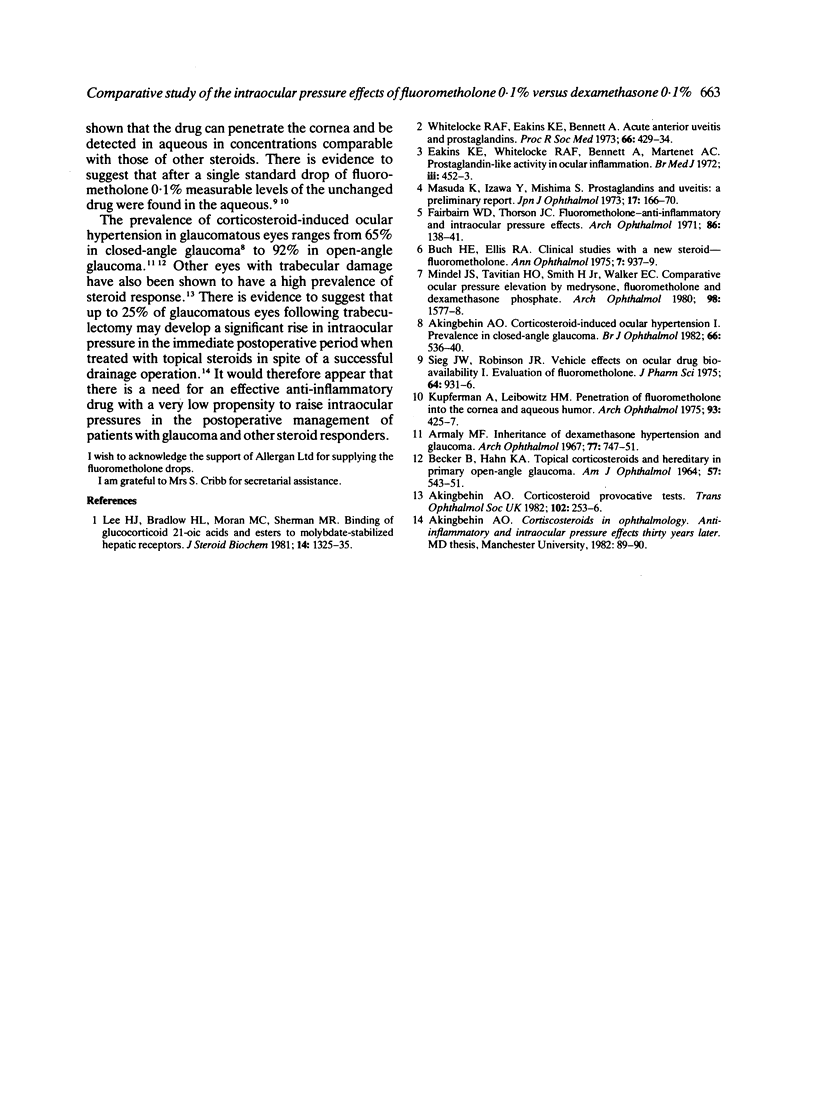Abstract
The intraocular pressure effect of fluorometholone 0.1% was compared with that of dexamethasone 0.1% by performing corticosteroid provocative tests on 24 matched pairs of eyes. Fifteen of the 24 dexamethasone treated eyes, 62.5%, showed a change in intraocular pressure greater than 5 mmHg, with mean delta P = 8.58 mmHg and range 0 to +20 mmHg. Only 2 of the 24 fluorometholone treated eyes, 8.3%, showed a change in pressure greater than 5 mmHg, with mean delta P = 2.96 mmHg and range -2 to +14 mmHg. There was a highly statistically significant difference between the intraocular pressure effects of topical dexamethasone and fluorometholone (correlated t test, p less than 0.001). Fluorometholone would appear to be the topical steroid of choice for patients with glaucoma and other known steroid responders when topical steroid treatment is indicated.
Full text
PDF


Selected References
These references are in PubMed. This may not be the complete list of references from this article.
- Akingbehin A. O. Corticosteroid-induced ocular hypertension. I. Prevalence in closed-angle glaucoma. Br J Ophthalmol. 1982 Aug;66(8):536–540. doi: 10.1136/bjo.66.8.536. [DOI] [PMC free article] [PubMed] [Google Scholar]
- Akingbehin T. Corticosteroid provocative tests. Trans Ophthalmol Soc U K. 1982 Jul;102(Pt 2):253–256. [PubMed] [Google Scholar]
- Armaly M. F. Inheritance of dexamethasone hypertension and glaucoma. Arch Ophthalmol. 1967 Jun;77(6):747–751. doi: 10.1001/archopht.1967.00980020749006. [DOI] [PubMed] [Google Scholar]
- BECKER B., HAHN K. A. TOPICAL CORTICOSTEROIDS AND HEREDITY IN PRIMARY OPEN-ANGLE GLAUCOMA. Am J Ophthalmol. 1964 Apr;57:543–551. doi: 10.1016/0002-9394(64)92500-0. [DOI] [PubMed] [Google Scholar]
- Buch H. E., Ellis R. A. Clinical studies with a new steroid--fluorometholone. Ann Ophthalmol. 1975 Jul;7(7):937–939. [PubMed] [Google Scholar]
- Eakins K. E., Whitelocke R. A., Bennett A., Martenet A. C. Prostaglandin-like activity in ocular inflammation. Br Med J. 1972 Aug 19;3(5824):452–453. doi: 10.1136/bmj.3.5824.452. [DOI] [PMC free article] [PubMed] [Google Scholar]
- Fairbairn W. D., Thorson J. C. Fluorometholone. Anti-inflammatory and intraocular pressure effects. Arch Ophthalmol. 1971 Aug;86(2):138–141. doi: 10.1001/archopht.1971.01000010140004. [DOI] [PubMed] [Google Scholar]
- Kupferman A., Leibowitz H. M. Penetration of fluorometholone into the cornea and aqueous humor. Arch Ophthalmol. 1975 Jun;93(6):425–427. doi: 10.1001/archopht.1975.01010020439008. [DOI] [PubMed] [Google Scholar]
- Lee H. J., Bradlow H. L., Moran M. C., Sherman M. R. Binding of glucocorticoid 21-oic acids and esters to molybdate-stabilized hepatic receptors. J Steroid Biochem. 1981 Dec;14(12):1325–1335. doi: 10.1016/0022-4731(81)90339-3. [DOI] [PubMed] [Google Scholar]
- Mindel J. S., Tavitian H. O., Smith H., Jr, Walker E. C. Comparative ocular pressure elevation by medrysone, fluorometholone, and dexamethasone phosphate. Arch Ophthalmol. 1980 Sep;98(9):1577–1578. doi: 10.1001/archopht.1980.01020040429006. [DOI] [PubMed] [Google Scholar]
- Sieg J. W., Robinson J. R. Vehicle effects on ocular drug bioavailability i: evaluation of fluorometholone. J Pharm Sci. 1975 Jun;64(6):931–936. doi: 10.1002/jps.2600640606. [DOI] [PubMed] [Google Scholar]
- Whitelocke R. A., Eakins K. E., Bennett A. Acute anterior uveitis and prostaglandins. Proc R Soc Med. 1973 May;66(5):429–434. doi: 10.1177/003591577306600506. [DOI] [PMC free article] [PubMed] [Google Scholar]


